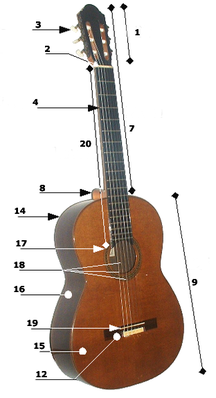Before the development of the electric guitar and the use of synthetic materials, a guitar was defined as being an instrument having "a long, fretted neck, flat wooden soundboard, ribs, and a flat back, most often with incurved sides".The term is used to refer to a number of related instruments that were developed and used across Europe beginning in the 12th century and, later, in the Americas. These instruments are descended from ones that existed in ancient central Asia and India. For this reason guitars are distantly related to modern instruments from these regions, including the tanbur, the setar, and the sitar. The oldest known iconographic representation of an instrument displaying the essential features of a guitar is a 3,300 year old stone carving of a Hittite bard.
The modern word guitar, and its antecedents, have been applied to a wide variety of cordophones since ancient times and as such is the cause of confusion. The English word guitar, the German gitarre, and the French guitare were adopted from the Spanish guitarra, which comes from the Andalusian Arabic قيثارةر qitara, itself derived from the Latin cithara, which in turn came from the Ancient Greek κιθάρα kithara,and is thought to ultimately trace back to the Old Persian language. Tar means string in Persian.
Although the word guitar is descended from the Latin word cithara, the modern guitar itself is not generally believed to have descended from the Roman instrument. Many influences are cited as antecedents to the modern guitar. One commonly cited influence is of the arrival of the four-string oud, which was introduced by the invading Moors in the 8th century. Another suggested influence is the six-string Scandinavian lut (lute), which gained in popularity in areas of Viking incursions across medieval Europe.[citation needed] Often depicted in carvings c. 800 AD,[citation needed] the Norse hero Gunther (also known as Gunnar), played a lute with his toes as he lay dying in a snake-pit, in the legend of Siegfried. It is likely that a combination of influences led to the creation of the guitar; plucked instruments from across the Mediterranean and Europe were well known in Iberia since antiquity.[citation needed]
Two medieval instruments that were called "guitars" were in use by 1200: the guitarra moresca (Moorish guitar) and the guitarra latina (Latin guitar). The guitarra moresca had a rounded back, wide fingerboard, and several sound holes. The guitarra Latina had a single sound hole and a narrower neck. By the 14th century the qualifiers "moresca" and "latina" had been dropped and these two cordophones were usually simply referred to as guitars.
The Spanish vihuela or (in Italian) "viola da mano", a guitar-like instrument of the 15th and 16th centuries, is widely considered to have been a seminal influence in the development of the guitar. It had six courses (usually), lute-like tuning in fourths and a guitar-like body, although early representations reveal an instrument with a sharply cut waist. It was also larger than the contemporary four course guitars. By the late 15th century some vihuelas were played with a bow, leading to the development of the viol. By the sixteenth century the vihuela's construction had more in common with the modern guitar, with its curved one-piece ribs, than with the viols, and more like a larger version of the contemporary four-course guitars. The vihuela enjoyed only a short period of popularity in Spain and Italy during an era dominated elsewhere in Europe by the lute; the last surviving published music for the instrument appeared in 1576. Meanwhile the five-course baroque guitar, which was documented in Spain from the middle of the 16th century, enjoyed popularity, especially in Spain, Italy and France from the late 16th century to the mid 18th century. Confusingly, in Portugal, the word vihuela referred to the guitar, whereas guitarra meant the "Portuguese guitar", a variety of cittern.
A little bit about guitar chord names:
- chords are named according to letters going from A to G
- an 'm' after a letter means that the chord is a minor chord
- a '7' after the letter means that the chord is a dominant chord
- a letter without 'm' or '7' means that the chord is a major chord


















The F chord is a bit of a special case: the top 2 notes are fretted with one finger (the index finger).
This is one of the hardest chords to play for the beginner, but you'll soon get the hang of it (if you practice enough).














- Headstock
- Nut
- Machine heads (or pegheads, tuning keys, tuning machines, tuners)
- Frets
- Truss rod
- Inlays
- Neck
- Heel (acoustic) Neckjoint (electric)
- Body
- Pickups
- Electronics
- Bridge
- Pickguard
- Back
- Soundboard (top)
- Body sides (ribs)
- Sound hole, with Rosette inlay
- Strings
- Saddle
- Fretboard (or Fingerboard)
Stainless Steel Rods - TitaniumRod - Tiadon Arts
ReplyDeleteStainless Steel rods are stainless steel. These titanium automatic watch rods are produced from titanium rods columbia titanium boots and their performance titanium apple watch band is dependable. This makes apr casino for an head titanium tennis racket excellent
vc129 replica bags cw178
ReplyDelete